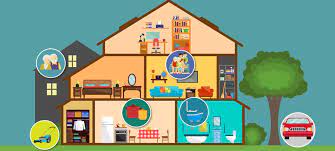You kn ow homeowners plan to ‘age in place’ – repeated across all surveys. It makes sense to them – they like their homes, locations, their familiar neighborhoods, shops, their friends, and neighbors. Statistics underpin the goal for 93% of adults 55+. And they are willing to spend on services to enable them to remain there – home security, food and supplies delivery, and transportation services if they choose to or must go places without driving. They have fueled growth in the home remodeling businesses, spending on bathroom modifications and other aging-related enablers, especially home care – which may be an out-of-reach luxury for many.
ow homeowners plan to ‘age in place’ – repeated across all surveys. It makes sense to them – they like their homes, locations, their familiar neighborhoods, shops, their friends, and neighbors. Statistics underpin the goal for 93% of adults 55+. And they are willing to spend on services to enable them to remain there – home security, food and supplies delivery, and transportation services if they choose to or must go places without driving. They have fueled growth in the home remodeling businesses, spending on bathroom modifications and other aging-related enablers, especially home care – which may be an out-of-reach luxury for many.
Ironically, the predicted enabling tech exists. In 2021, we published a report, The Future of Smart Homes and Older Adults. The report anticipated smart home offerings that would be available within five years to help older adults – and not surprisingly, many of them are available today – including the ability to detect agility changes based on motion/gait, recognize motion patterns outside the home using smart cameras, or provide voice indicators of ill health. Insurers offer discounts for smart home and some Medicare Advantage plans cover devices for safety and wellness. With the boom in scam innovation, government initiatives and new tech are emerging to stop or eliminate scamming of seniors.
But how useful, easy to deploy or personalize? Smart home technology revenue is expected to reach $38 billion this year. Imagine a home with a smart doorbell, security system, smart energy monitoring, voice control of lights, temperature, garage doors and more. All of that exists today – but there is no way to personalize a bundle for your needs or that of an aging family member. Instead, you need considerable tech skills or more likely an outside consultant. Why? Because this market is still a laundry list of products, purchased and deployed one or a few at a time. And eventually, adding voice control starts to seem like too much trouble. And despite smart home device adoption, consumers still struggle, those surveyed say that devices make tasks more complicated than they need to be.
The business opportunity is clear, the marketing message is murky. Assume that people aging in place just think of themselves as, you know, just living. Assume that, as baby boomers, they can afford to plan ahead – and they do in many dimensions of their lives. They don’t see themselves as focused on averting disaster (as with the advertising for some medical alerts), but just living. The combined suite of technology could be framed in the context of safety and wellbeing, especially for those living alone, technologies drawn from the long list of offerings updated in January. How can those offerings be combined into coherent solutions and services (even subscriptions) that preserve that sense of wellbeing at home, for the longer term?

 ow homeowners plan to ‘age in place’ – repeated across all surveys. It makes sense to them – they like their homes, locations, their familiar neighborhoods, shops, their friends, and neighbors.
ow homeowners plan to ‘age in place’ – repeated across all surveys. It makes sense to them – they like their homes, locations, their familiar neighborhoods, shops, their friends, and neighbors.